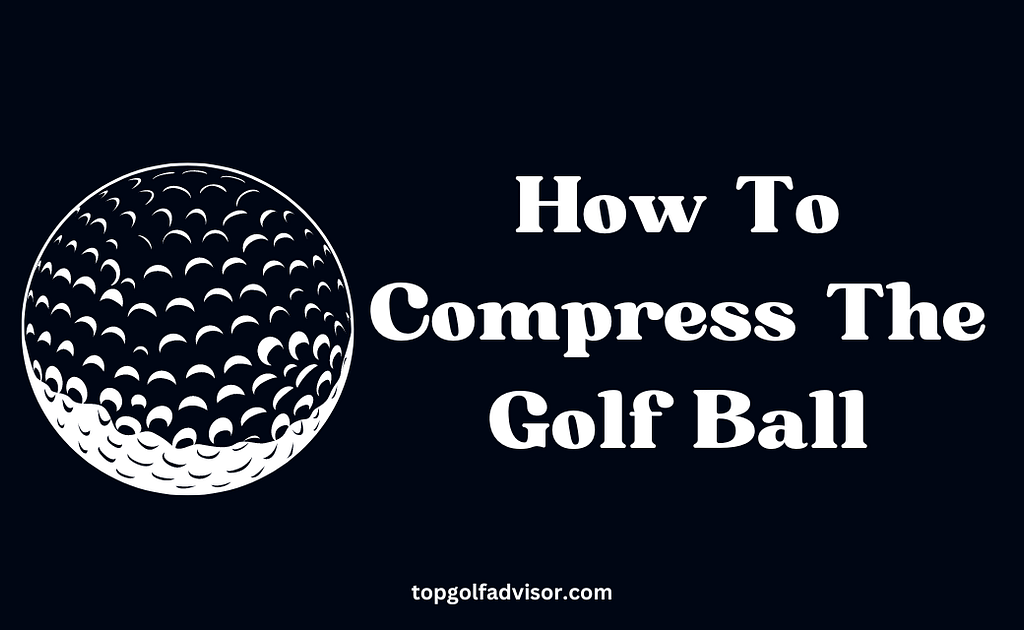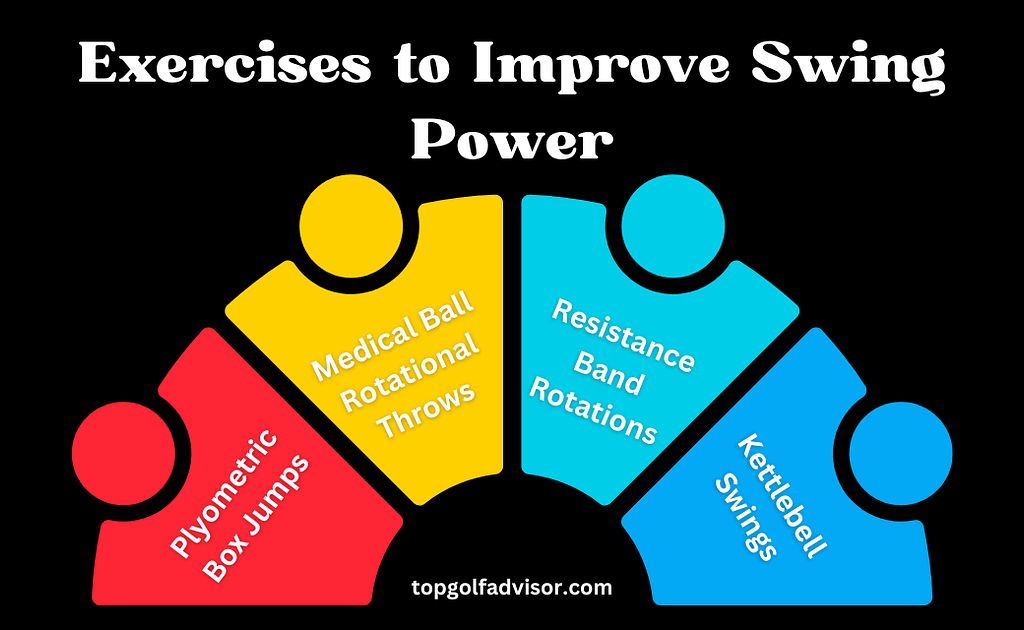One of the most often queries we field is, “How to compress the golf ball?” It’s a pretty fascinating one because most of the time when you’re working on your swings, you’re thinking about how to get into a certain position on the downswing or better your takeout. However, a player must gain a better knowledge of what impact looks like because the ball only truly knows contact.
We will also go into course management, mental tactics, and ongoing development methods to help you get even better at compressing the golf ball.
Now that you’re prepared to advance your golf skills, let’s get started and discover how to compress the ball like a pro.

Mastering Your Swing Technique
Enhance your swing method to produce a more potent and fulfilling hit. Developing your swing mechanics is crucial to successfully compressing the golf ball.
It calls for a blend of timing, coordination, and good body mechanics.
First, pay attention to your grasp. Make sure your hands remain neutral and hold the club with a solid but relaxed grip. Better control and power transfer will be possible during the swing as a result.
Work on your alignment and stance after that. Place your feet shoulder-width apart and align yourself perpendicular to the target line. Place equal weight on each foot and flex your knees just a little. A strong swing will have a solid base thanks to this well-balanced setup.
Use your body rotation as you begin to swing. With your left arm still straight, begin the backswing by rotating the upper part of your body away from the target. Next, rotate your hips and lower torso in the direction of the target to start the downswing and impart energy to the club.
Don’t forget to swing at a steady pace the entire time. Steer clear of jerky or hurried motions as these can cause your ball compression to suffer. To achieve the most power and control, concentrate on moving in a steady, flowing manner.
Building Strength and Flexibility
You can perform particular exercises that will help you produce greater force and speed in order to boost your swing power.
Incorporating a warm-up and stretching regimen into your golf practice will also help you become more flexible and avoid injuries.
Lastly, to improve your overall swing technique, make sure to concentrate on core-strengthening activities. A strong core is essential to attaining appropriate compression of the golf ball.
Exercises to Improve Swing Power
Think of yourself performing these explosive exercises with easy great swing power. Through the inclusion of targeted workouts in your training regimen, you can increase your swing force and eventually learn how to compress the golf ball to an unprecedented degree.
The following four workouts are essential for maximizing your swing power:
1. Medical Ball Rotational Throws: Using both hands, hold a medicine ball and swivel your torso to toss it explosively to a partner or into a wall. Stand with your toes shoulder-width apart.
2. Plyometric Box Jumps: Focus on explosive power and maximal height when you jump onto a strong box or platform. The strength in the lower body required for a strong swing will be developed with this workout.
3. Resistance Band Rotations: Rotate your body against the resistance by fastening the band to a stationary object, holding the other end with both hands and rotating. Your rotational power will increase and your core will get stronger with this workout.
4. Kettlebell Swings: Using both hands, grasp a kettlebell, flex at the hips, and swing it forcefully to shoulder height. This workout will strengthen your posterior chain and hip flexors.
By including these workouts in your training regimen, you will be able to produce more swing power and easily compress the golf ball.

Stretching and Warm-Up Routine
Prepare to improve your swing force and stave off injuries with this efficient warm-up and stretching regimen for golf.
It’s crucial to get your body ready for the strenuous game of golf before you set foot on the course. To begin, turn your neck slightly back and forth. Next, perform arm circles and shoulder rolls to further loosen up your upper body.
After that, concentrate on your lower body by stretching your hamstrings and quadriceps while standing. Remember to strengthen your core by performing some standing side twists and bends to activate your abdominal muscles.
Lastly, do some light wrist twists and finger stretches to warm up your hands and wrists. You may raise your swing power, decrease your chance of injury, and increase your flexibility by spending just a few minutes warming up and stretching. These tactics are wonderful in ensuring you learn how to compress the golf ball.
Importance of Core Strength in Compression
Building a strong core is essential to hitting with the most power and control possible. Your golf ball is compressed by your core muscles, which helps you hit the ball with more distance and precision.
It is challenging to keep a steady posture and effectively transfer energy from the floor to the clubhead when your core is weak. By strengthening your core, you’ll be able to twist your torso more effectively, which will increase the speed and force of your swing. Longer drives along with a more consistent ball flight are the result of being able to compress the golf ball effectively.
Exercises such as medicine ball tosses, planks, and Russian twists can help strengthen your core and ultimately improve your compression abilities on the golf field. Dive into the fundamentals of golf ball characteristics while exploring what is the size of a golf ball. The size plays a crucial role in compression, and understanding it can refine your strategy on the course.
Proper Hand and Arm Positioning
By putting your hands and arms in the right places, you can maximize your power and control, compress the golf ball like a pro, and enjoy the rush of hitting a flawless shot.
Starting with your top hand grasping the club somewhat stronger than your bottom hand, you can attain the optimal hand and arm position. This will support the impression of a square clubface.
Then, upon address, place your hands just ahead of the ball to encourage a downward strike and guarantee firm contact.
Keep your hands and arms flexible and do not tense up too much as you swing. This will help you produce greater power and enable a smoother, more fluid swing.
Maintaining a Flat Swing Plane
A level swing plane must be maintained to make accurate and reliable strokes. It enables you to precisely deliver the club’s head to the ball and easily transition through your swing. A flat swing plane allows the clubhead to remain on the same plane during the swing, which improves energy transmission to the ball.
Keep your hands and arms close to your body to achieve a flat swing plane. Do not raise or lower them while they are swinging. Up to impact, maintain a straight lead arm and a hinged wrist. Furthermore, ensure that your hips and torso are correctly rotated to permit a complete and balanced swing.
Maximizing Clubface Contact
With perfect accuracy and power, you may launch the ball skyward by making sure your clubface makes firm contact with the ball. Achieving maximum distance and compressing the golf ball requires maximizing clubface contact.
Pay attention to your alignment and setup to do this. To ensure that the clubface aligns correctly, ensure your feet, hips, and shoulders are square to the target line. Remain comfortable in your grasp; stress can result in mishits. Maintain eye contact with the ball and aim to strike it with the middle of the clubface as you swing. This will enable you to deliver a precise and potent blow.
Course Management for Compression
Make the most of the compression potential of your golf ball by using sensible course management techniques. You can make sure that you’re positioning yourself for the best compression and distance on the course with every stroke by making wise judgments while playing.
The following three pointers will assist you in managing your courses on how to compress the golf ball:
- Analyze the conditions: Give the condition of the course some thought before each shot. Consider factors such as the firmness of the fairway, the location of hazards, and the wind’s direction and speed. By choosing the appropriate club and shot shape and being aware of these conditions, you can maximize compression.
- Make a plan for your approach: Spend some time planning how to get to each hole before you tee off. Take into account the fairway’s design, the flag’s location, and any possible hazards. You can get more distance and control by positioning yourself in the ideal area for a compressed shot by carefully planning your approach.
- Pick the appropriate target: It’s crucial to pick a location that maximizes compression while shooting for a certain target. Seek for sections of the fairway or green where there is less chance of running into hazards and a clear route. You can improve your chances of success and attain optimal compression by selecting the appropriate goal.

You may increase the compression potential of your golf ball and raise your game on the course by putting these course management techniques into practice. To optimize your compression and improve your game, keep these things in mind the next time you’re out in the field: evaluate the conditions, prepare your strategy, and select the appropriate target.
Conclusion
So there you have it, a comprehensive guide on how to compress the golf ball. By understanding the science behind compression, mastering your swing technique, and building strength and flexibility, you can achieve that solid impact you’ve been striving for.
Remember also to familiarize yourself with ball flight laws, practice with purpose, and implement mental strategies for compression.
And don’t forget about course management and continuous improvement.
With these tips and strategies, you’ll be well on your way to compressing the golf ball like a pro. Keep practicing
FAQs
Are there any specific golf ball brands or models that are known to be easier to compress?
Certain golf ball models and brands, such as the Callaway Chrome Soft and Titleist Pro V1, are recognized for being less difficult to compress. These balls respond better to your swing because of their softer cover materials and cores.
Can compression be improved solely by focusing on swing technique, or are there other factors to consider?
Swing technique alone won’t always result in better compression. A number of other variables come into play, including temperature, clubhead speed, and ball construction. To get the best results, practice your swing and try different balls.
Are any specific drills or exercises recommended to build strength and flexibility for better ball compression?
Exercises targeting your upper, lower, and core should be your main emphasis if you want to increase your flexibility and strength for improved ball compression. Include exercises like medicine ball tosses and golf-specific stretches that enhance rotational power and flexibility.
How much difference do temperature and weather conditions make in terms of ball compression?
Ball compression does vary depending on temperature and meteorological circumstances. Ball compression is reduced in colder conditions, resulting in shorter ball distances. Warm weather increases ball compression, which extends the ball’s range. So, while playing golf, pay attention to the weather.
